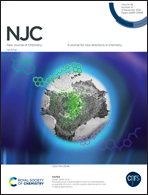On-surface homocoupling reactivity of a chiral bifunctional bromoindanone molecule on Cu(111)†
Abstract
On-surface synthesis has provided exciting concepts for the building of covalently bonded molecular nanostructures as well as the exploration of new synthetic pathway alternatives to chemical synthesis in solution. The surface-supported reaction of precursor molecules can result in the formation of 2D molecular networks as well as novel 0D molecular structures. In this study, we investigate the adsorption of a chiral molecule (R)-6-bromo-3-phenyl-2,3-dihydro-1H-inden-1-one (BrPhINDO) on the Cu(111) surface under ultrahigh vacuum conditions by low-temperature scanning tunneling microscopy and core-level photoemission spectroscopy. Annealing an as-deposited layer of molecules allows two kinds of homocoupling reactions to be activated, the Ullmann-like coupling reaction and the Knoevenagel reaction, resulting in the formation of various low-dimensional structures. By studying their prochirality and comparing with the products obtained using an enantiomer precursor, we demonstrate adsorption-induced chiral inversion inducing partial racemization.



 Please wait while we load your content...
Please wait while we load your content...